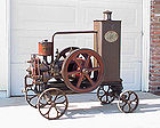
Stationary engine
Overview
Pump
A pump is a device used to move fluids, such as liquids, gases or slurries.A pump displaces a volume by physical or mechanical action. Pumps fall into three major groups: direct lift, displacement, and gravity pumps...
or power tool. They may be powered by steam
Stationary steam engine
Stationary steam engines are fixed steam engines used for pumping or driving mills and factories, and for power generation. They are distinct from locomotive engines used on railways, traction engines for heavy steam haulage on roads, steam cars , agricultural engines used for ploughing or...
; or oil-burning or internal combustion engines.
They come in a wide variety of sizes and are used a wide variety of purposes. These include: powering water pumps in mines and for water supply and sewage removal systems, driving textile processing machinery in textile mill
Cotton mill
A cotton mill is a factory that houses spinning and weaving machinery. Typically built between 1775 and 1930, mills spun cotton which was an important product during the Industrial Revolution....
s, driving pit head winding gear
Winding engine
A winding engine is a stationary engine used to control a cable, for example to power a mining hoist at a pit head. Electric hoist controllers have replaced proper winding engines in modern mining, but use electric motors that are also traditionally referred to as winding engines.Most proper...
, electricity generation
Power station
A power station is an industrial facility for the generation of electric energy....
, and powering agricultural equipment.
- Stationary steam engineStationary steam engineStationary steam engines are fixed steam engines used for pumping or driving mills and factories, and for power generation. They are distinct from locomotive engines used on railways, traction engines for heavy steam haulage on roads, steam cars , agricultural engines used for ploughing or...
- Hit and miss engineHit and miss engineA hit-and-miss engine is a type of four-stroke internal combustion engine that was conceived in the late 19th century and was produced by various companies from the 1890s through approximately the 1930s. The name comes from the method of speed control that is implemented on these engines...
- Hot bulb engineHot bulb engineThe hot bulb engine, or hotbulb or heavy oil engine is a type of internal combustion engine. It is an engine in which fuel is ignited by being brought into contact with a red-hot metal surface inside a bulb....
- Hot tube engineHot tube engineThe hot tube engine is a relative of the hot bulb engine with better timing control. The hot bulb engine only ran well at one speed- and a low one at that, typically 100 RPM. The timing of a hot tube engine is controlled by means of varying the length of the Hot-tube ignitor, which is longer and...
Small stationary engines were frequently used on farm
Farm
A farm is an area of land, or, for aquaculture, lake, river or sea, including various structures, devoted primarily to the practice of producing and managing food , fibres and, increasingly, fuel. It is the basic production facility in food production. Farms may be owned and operated by a single...
s to drive various kinds of power tool
Power tool
A power tool is a tool that is actuated by an additional power source and mechanism other than the solely manual labour used with hand tools. The most common types of power tools use electric motors. Internal combustion engines and compressed air are also commonly used...
s and equipment such as circular saw
Circular saw
The circular saw is a machine using a toothed metal cutting disc or blade. The term is also loosely used for the blade itself. The blade is a tool for cutting wood or other materials and may be hand-held or table-mounted. It can also be used to make narrow slots...
s, pump
Pump
A pump is a device used to move fluids, such as liquids, gases or slurries.A pump displaces a volume by physical or mechanical action. Pumps fall into three major groups: direct lift, displacement, and gravity pumps...
s, and hay elevators.
Unanswered Questions

